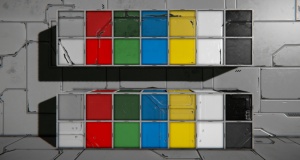Difference between revisions of "Armor block"
(→Armor Details: cleanup, add rounded and smooth sections) |
(→Block) |
||
| Line 42: | Line 42: | ||
===Block === | ===Block === | ||
| − | It is most basic cube block. It conducts control commands, [[electricity]] and has randomly generated texture, that connects to other blocks. On small ships it | + | It is the most basic cube block. It conducts control commands, [[electricity]] and has randomly generated texture, that connects to other blocks. On small ships it has an edge length of 0.5 meters (0.125 m³ volume); on large ships its edge length is 2.5 meters (15.625 m³ volume). |
===Corner === | ===Corner === | ||
Revision as of 11:51, 2 March 2016
These blocks are the icon of Space Engineers. They are basic building blocks, and no ship or station, small or large, can be built without them.
Contents
Light Armor
The light armor block is (as the name says) light, cheap and not very resistant. They are mostly used as a foundation for the ship/station, or for aesthetics, because connected faces at the same angle are seamless. For firepower protection, Heavy Armor is preferred.
Heavy Armor
As the name says, it's the heavier, sturdier and more expensive counterpart of Light Armor. Because of its mass, en masse usage is not recommended, as you will need to build more thrusters to maintain the acceleration power of the ship. For stations, the only downside remains its Steel Plate cost. To differentiate it from the light armor blocks, it has a camo pattern texture (see below).
Deformation
deformation and block integrity are factors in determining the relative strength and resistance to damage.
explosion/collision resist = integrity / deformation
The lower the deformation ratio, the stronger the block is against impact damage such as collisions and weapons. [Citation Needed]
See Weapons
<needs more info>
Armor Details
Block
It is the most basic cube block. It conducts control commands, electricity and has randomly generated texture, that connects to other blocks. On small ships it has an edge length of 0.5 meters (0.125 m³ volume); on large ships its edge length is 2.5 meters (15.625 m³ volume).
Corner
This is 1/6 of a default armor block and can be rotated to make more aesthetically pleasing ships or stations. They match up (as in, without seams) to slope armor blocks and inverted corner armor blocks, but not with standard armor blocks. This block is the most limited in terms of ability to weld to other blocks, as it can only be connected on three sides.
Slope
Half of an armor block, these blocks can double as steep, 45º angle ramps on stations or large ships. The blocks will match up (as in, without seams) to corner blocks and inverted corner blocks on its sides and match up to the default armor blocks its two square faces. This block can be welded to other blocks on four of its five sides.
Inverted Corner
This is 5/6 of an armor block. These oddly shaped blocks allow for the completion of slanted ship designs, able to integrate with standard armor blocks on three sides, and slope or corner armor blocks from the other three sides. By using corners and inverted corners you can create bevelled corner "faces".
Rounded Blocks
These blocks are similar to the regular blocks except the have a rounded face instead of being flat. They provide a different look to having flat surfaces. Four round(ed) slops will form a circle, eight round(ed) corners will make a sphere.
Smooth Blocks
These blocks will "pull" their surrounding blocks towards themselves when created. It's possible to create different angles and slopes by using a combination of smooth blocks. (More investigation is required.)
Coloring Blocks
All blocks are able to be colored, and have a default color of Gray. The other presets, Red, Green, Blue, Yellow, White, and Black (in two different shades each), can be selected when placing a block using the "Prev. Color" and "Next Color" keys (defaults: '[', ']'). See Building#Color for more information about coloring blocks.
Update History
| Update 01.002.014 |
|
